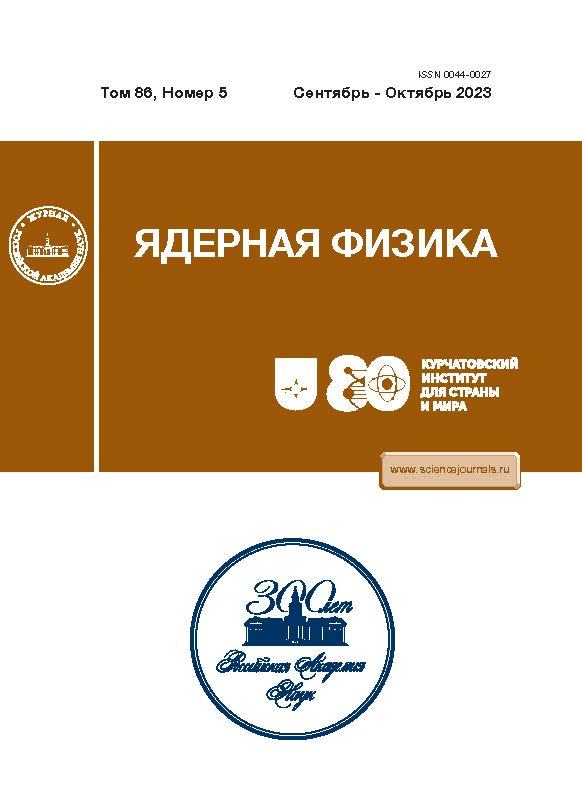SEARCH FOR HEAVY NEUTRINOS IN THE DECAY OF THE D+s MESON
- Autores: Ivanov K.M.1, Chistov R.N.1,2
-
Afiliações:
- Moscow Institute of Physics and Technology (National Research University)
- Lebedev Physical Institute, Russian Academy of Sciences
- Edição: Volume 86, Nº 5 (2023)
- Páginas: 628-633
- Seção: МАТЕРИАЛЫ 6-ОЙ МЕЖДУНАРОДНОЙ КОНФЕРЕНЦИИ “ICPPA-2022”. Элементарные частицы и поля
- ##submission.datePublished##: 01.09.2023
- URL: https://cardiosomatics.ru/0044-0027/article/view/674694
- DOI: https://doi.org/10.31857/S0044002723050227
- EDN: https://elibrary.ru/IDXKBG
- ID: 674694
Citar
Texto integral
Resumo
This work is devoted to the search for a hypothetical heavy sterile neutrino N on CMS data at the Large Hadron Collider, where N is born in the decay of a D+s meson with a violation of the lepton number D+s→μ+N→μ+μ+π-, and the source of D+s mesons are semilepton decays B0s→D+sμ−vˉμ. Studies of Monte Carlo simulations of signal decay modeled under CMS detector conditions are presented. Several possible points in the parameter space of a heavy neutrino (mN,|VμN|2) have been generated and studied, where mN and |VμN|2 are the mass and the mixing parameter, respectively.The kinematic and topological parameters involved in particle decay were studied, and the efficiency of the generator and reconstruction were evaluated. The results obtained will be used for the subsequent search for the decay of D+s→µ+N on CMS data.
Sobre autores
K. Ivanov
Moscow Institute of Physics and Technology (National Research University)
Email: ivanov.km@phystech.edu
Dolgoprudny, Moscow oblast, Russia
R. Chistov
Moscow Institute of Physics and Technology (National Research University); Lebedev Physical Institute, Russian Academy of Sciences
Autor responsável pela correspondência
Email: ivanov.km@phystech.edu
Dolgoprudny, Moscow oblast, Russia; 119991, Moscow, Russia
Bibliografia
- R. L. Workman et al. (Particle Data Group), PTEP 2022, 083C01 (2022).
- T. Asaka, S. Blanchet, and M. Shaposhnikov, Phys. Lett. B 631, 151 (2005), hep-ph/0503065.
- T. Asaka and M. Shaposhnikov, Phys. Lett. B 620, 17 (2005), hep-ph/0505013.
- D. Gorbunov and M. Shaposhnikov, JHEP 0710, 015 (2007) [JHEP 1311, 101 (Erratum)], arXiv: 0705.1729.
- Д. С. Горбунов, УФН 184, 545 (2014).
- M. T. Prim et al. (Belle Collab.), Phys. Rev. D 101, 032007 (2020), arXiv: 1911.03186.
- R. Aaij et al. (LHCb Collab.), Phys. Rev. Lett. 112, 131802 (2014), arXiv: 1401.5361.
- Я. А. Андреев, К. М. Иванов, Р. Н. Чистов, Краткие сообщения по физике ФИАН 50 (1), 42 (2023).
- T. Sjostrand, S. Ask, J. R. Christiansen, R. Cor- ke, N. Desai, P. Ilten, S. Mrenna, S. Prestel, C. O. Rasmussen, and P. Z. Skands, Comput. Phys. Commun. 191, 159 (2015), arXiv: 1410.3012.
- D. Lange, Nucl. Instrum. Methods A 462, 152 (2001).
- E. Barberio, B. van Eijk, and Z. Was, Comput. Phys. Commun. 66, 115 (1991).
- E. Barberio and Z. Was, Comput. Phys. Commun. 79, 291 (1994).
- S. Chatrchyan et al. (CMS Collab.), JINST 3, S08004 (2008).
- S. Agostinelli et al. (GEANT4 Collab.), Nucl. Instrum. Methods A 506, 250 (2003).
- B. Shuve and M. E. Peskin, Phys. Rev. D 94, 113007 (2016), arXiv: 1607.04258.
Arquivos suplementares










